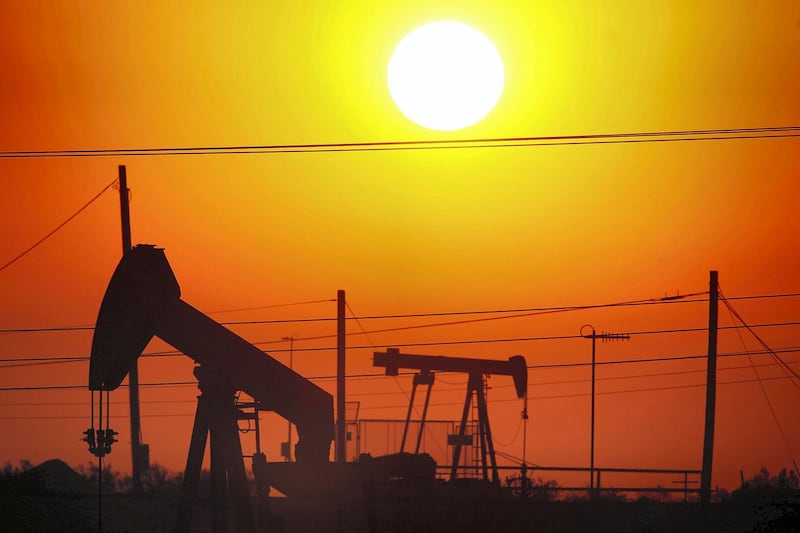Oil prices extended losses on Wednesday after falling by as much as 4 per cent the previous day amid concerns of aggressive interest rate increases by the US Federal Reserve to fight inflation, which could slow economic growth and dampen crude demand.
Brent, the benchmark for two thirds of the world’s oil, was 1.22 per cent lower at $82.27 a barrel at 8.10pm UAE time.
West Texas Intermediate, the gauge that tracks US crude, was down 1.57 per cent at $76.36 a barrel.
On Tuesday, Brent settled 3.35 per cent lower at $83.29 a barrel while WTI was down 3.58 per cent at $77.58.
“[Futures] slumped along with most other risk assets in response to commentary from [Fed chairman] Jerome Powell that suggested rate hikes would need to accelerate once again,” said Jeanne Claire Walters, a senior economist at Emirates NBD.
At a Congressional hearing on Tuesday, Mr Powell hinted that interest rates may need to increase further and at a faster pace than previously anticipated following stronger-than-expected US economic data for January.
“Although inflation has been moderating in recent months, the process of getting inflation back down to 2 per cent has a long way to go and is likely to be bumpy,” said Mr Powell.
“If the totality of the [economic] data were to indicate that faster tightening is warranted, we would be prepared to increase the pace of rate hikes.”
After its February meeting, the Fed raised interest rates by 25 basis points — the eighth increase since March 2022. The Fed's next meeting is scheduled to take place from March 21 to March 22.
“If the US jobs data remains strong, and inflation won’t cool down, the Fed will throw the slower-but-higher-rate-hikes strategy out of the window, and they will just hike by decent chunks,” said Ipek Ozkardeskaya, a senior analyst at Swissquote Bank.
“And the level of rates will … be higher than 5.1 per cent.”
The Fed is not “worried” about the economic data, said Naeem Aslam, chief investment officer at Zaye Capital Market.
“The message from the chairman was that the data is telling them a compelling story that the US economy is standing on a strong footing and there is a strong need for interest rates to rise at a faster level,” he said.
“The fact that the Fed has adopted a hawkish monetary policy stance once again has made traders worried and they are concerned that the Fed may be overconfident with its approach.”
Market speculators believe that the next interest rate increase by the Fed will be 50 bps, Mr Aslam said.
Investors will be closely watching the US non-farm payrolls report for February, which will be released on March 10.
The consumer price index, a key measure of inflation, is due on March 14.
On Tuesday, Opec secretary general Haitham Al Ghais expressed cautious optimism at China's reopening but said a slowdown in the US and the EU could dampen crude oil demand this year.
“There is phenomenal demand growth in Asia [but] what concerns us more is actually the slowdown we see in Europe and the US in terms of the financial situation [and] the inflation,” Mr Al Ghais said at the CeraWeek energy conference in Houston on Tuesday.
“We see a kind of a divided market … one market with promising growth [and] the other side with a slowdown.”
Last month, Opec raised its 2023 oil demand forecast by 100,000 barrels per day amid expectations of an economic rebound in China, the world's largest crude importer.
The group expects global oil demand to grow by 2.3 million bpd this year, which is higher than its previous estimate of 2.2 million bpd.
China alone will count for about 500,000 bpd to 600,000 bpd of demand improvement, the Opec chief said.
The Opec chief also said he was not concerned about the redirection of Russian crude oil to Asia.
“We've always seen redirection of flows, whether it's related to geopolitical events or demand centres being created [or] others disappearing,” said Mr Al Ghais.
“I think the market is actually big enough with demand improving.”
Despite western sanctions, Russian oil exports in January rose by 300,000 bpd from a month ago to 8.2 million bpd, the International Energy Agency reported last month.
The Paris-based agency expects global oil demand to surge to record levels this year, driven by China’s economic recovery.
Demand is projected to rise by two million bpd to 101.9 million bpd this year, the Paris-based agency said in its February oil market report. It previously forecast a growth of 1.9 million bpd.






